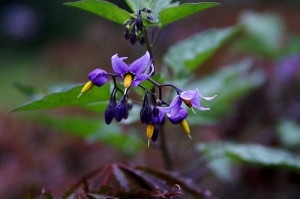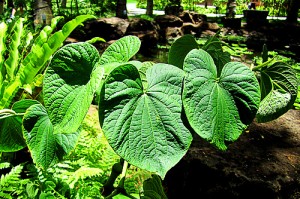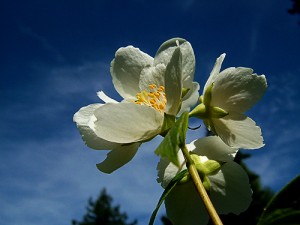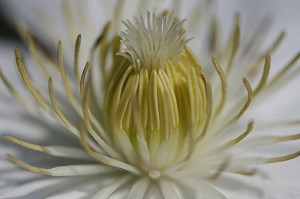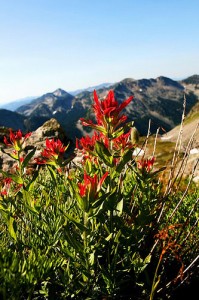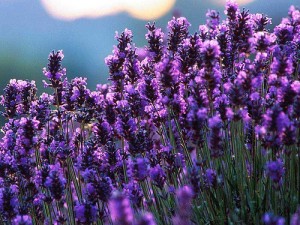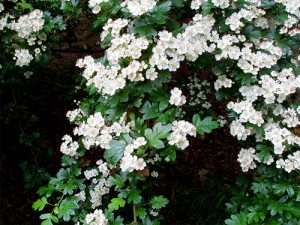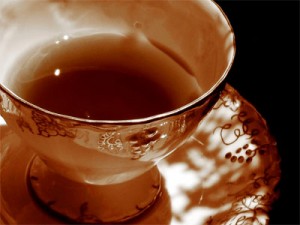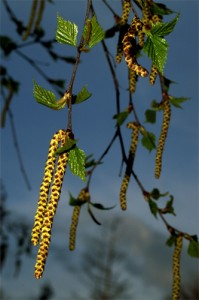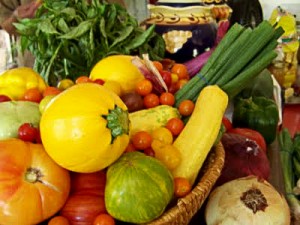Belladonna
Botanical Name: Atropa Belladonna or Atropa Bella-Donna
Belladonna (also called Deadly Nightshade or Devil’s Berries) is a perennial herbaceous plant in the Solanaceae family. Native to Europe, North Africa, and Western Asia, the foliage and berries are extremely toxic. The toxins are tropane alkaloids, containing scopolamine and hyoscyamine, which cause delirium and hallucinations.
Belladonna has a history of use in medicine, cosmetics, and poison. It was used as an anesthetic before the Middle Ages. The ancient Romans used it as a poison on arrow tips. Both the wife of Emperor Augustus and the wife of Claudius used it to murder contemporaries. The name “Bella-Don means “beautiful woman” in Italian, and the genus name “atropa” comes from Atropos, one of the three Fates in Greek mythology.
Belladonna’s most powerful effect is on the heart, lungs and blood vessels, as well as on the brain and nervous system.
It is an extremely poisonous plant, eating its cherry like fruit can lead to severe illness and in the worst cases, death. In modern pharmacology, the chemical atropine plays an important role. Small doses are incorporated into many heart medications. In homeopathic remedies, Belladonna is also dispensed in diluted, non toxic doses. Homeopaths can safely prescribe it for a broad range of purposes. (i.e. quick relief for fever, coughs, headaches and the flu) It is best given to those with particular character traits. (see below)
Belladonna Type:
Those most likely to benefit are extremely hot-headed and intelligent. Disease normally strikes unexpectedly, like a bolt of lightening. Symptoms can be relieved fairly quick, if treated correctly. Signs are a very flushed face and shiny skin.
Are you a Belladonna type? Check all that apply.
- You are prone to anxiety and have feelings of distress, agitation and uneasiness.
- Your face is strongly flushed by heat.
- Throbbing sensations in your head.
- You are nervous and easily excited.
- Restless sleep and nightmares.
- Arms and legs are cold, when your head is warm.
If you checked more than three, see information below on how Belladonna can benefit you.
Therapeutic Effects:
Belladonna has a calming effect on the central nervous system, the linings of the brain and spinal cord, the upper respiratory passages and the digestive tract, when used in its homeopathic form. It alleviates restlessness, anxiety and insomnia, and may also help to diminish painful sensitivity to light, touch or pressure.
Principle homeopathic uses:
Belladonna is commonly used to relieve facial flushing, fevers, chills and profuse sweating. It is also beneficial when used for tonsillitis, sore throats, fever induced hallucinations, severe headaches and PMS.
Preparation for the remedy:
The leaves, roots and fruit of the belladonna plant are ground up and mixed with alcohol to form the basic tincture, which is then diluted. It is recommended in a potency of 30 C.
Relief from nerve pain:
Belladonna may help alleviate nerve pain that comes on suddenly, and migrates to different areas of the body. It can subside just as fast as it comes on. Pain may be sharp or stabbing and can sometimes be temporarily relieved by moving the afflicted area. There may also be redness and swelling of the joints.
Prescribed for: Fever, gastritis, gout, headaches, hallucinations and insomnia, inflammations of the brain or spinal cord, stomach and digestive upset, menstrual cramps, manic depression and poisoning,
Indications:
Mood:
- Intense anxiety
- Sensitive to noise and light
- Insomnia and daytime sleepiness
- Not wanting to be touched
Head:
- Dry mouth and lack of taste
- Inflamed mucous membranes
- Loss of voice, dry throat
- Bloody secretions from the nose
- Hypersensitive scalp
- Hot, throbbing sensations in the head
Eyes:
- Glassy eyes with dilated pupils
- Dry, red eyes
- Extreme sensitivity to sunlight or glare
- Pulsing pains in the eyes
Skin:
- Burning sensations in the skin
- Bright and shiny skin, with some redness
- Painful abscesses and inflammations; warts
- Dry skin; inflamed areas may be sweaty
Extremities:
- Cold hands or feet (though the rest of the body, particularly the face, feels hot
- Inflammation in the upper arms or legs
- Acute pains in the arms; swollen joints
- Muscle spasms; twitching and jerking
Before a homeopath can prescribe Belladonna, he/she must know if your symptoms are affected by the conditions listed below.
Symptom Gauge:
Better:
- Bending forward
- Dark Places
- Rest
- Sweating & heat
Worse:
- Cold
- Drafts
- Light
- Motion or touch
- Noise
References:
- The Complete Guide To Natural Healing
Note: Consult with a Physician if you are seeking medical remedies. The information is not intended as medical advice. PagansWorld.org is not liable for the misuse of the information listed above.
Thanks for stopping by! Well wishes to you all and have a great day!
Lisa

